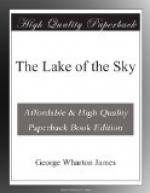Cliff-swallows often nest on the high banks at Tahoe City, and a few have been seen nesting under the eaves of the store on the wharf. The nests of barn swallows also have been found under the eaves of the ice-house.
Nor must the exquisite hummers be overlooked. In Truckee Canyon, and near Tahoe Tavern they are quite numerous. They sit on the telephone wires and try to make you listen to their pathetic and scarcely discernible song, and as you sit on the seats at the Tavern, if you happen to have some bright colored object about you, especially red, they will flit to and fro eagerly seeking for the honey-laden flower that red ought to betoken.
Several times down Truckee Canyon I have seen wild canaries. They are rather rare, as are also the Louisiana tanager, most gorgeous of all the Tahoe birds, and the black-headed grosbeak.
Of the wrens, both the rock wren and the canyon wren are occasionally seen, the peculiar song of the latter bringing a thrill of cheer to those who are familiar with its falling chromatic scale.
Then there is the merry chick-a-dee-dee, the busy creepers, and the nut-hatches hunting for insects on the tree trunks.
The harsh note of the blue jay is heard from Tahoe Tavern, all around the Lake and in almost every wooded slope in the Sierras. He is a noisy, generally unlovable creature, and the terror of the small birds in the nesting season, because of his well-known habit of stealing eggs and young. At Tahoe Tavern, however, I found several of them that were shamed into friendliness of behavior, and astonishing tameness, by the chipmunks. They would come and eat nuts from my fingers, and one of them several times came and perched upon my shoulder. There is also the grayish solitaire which looks very much like the mockingbird of less variable climes.
The foregoing account of the birds, which I submitted for revision to Professor Peter Frandsen, of the University of Nevada, called forth from him the following:
I have very little to add to this admirable bird account. Besides the gulls, their black relatives, the swallow-like terns, are occasionally seen. The black-crowned night-heron is less common than the great blue heron. Clarke’s crow is more properly called Clarke’s nutcracker—a different genus. The road robin or chewink is fairly common in the thickets above the Lake. Nuttal’s poor will, with its call of two syllables, is not infrequently heard at night. The silent mountain blue-bird, sialia arctica, is sometimes seen. So is the western warbling vireo. The solitary white-rumped shrike is occasionally met with in late summer. Owls are common but what species other than the western horned owl I do not know. Other rather rare birds are the beautiful lazuli bunting and the western warbling vireo. Among the wood-peckers I have also noted the bristle-bellied wood-pecker, or Lewis’s wood-pecker, Harris’s wood-pecker, and the downy wood-pecker.
ANIMALS. These are even more numerous than the birds, though except to the experienced observer many of them are seldom noticed.




